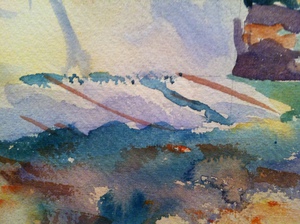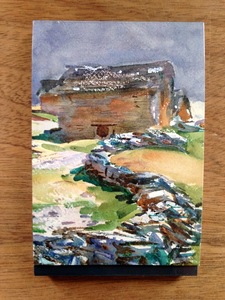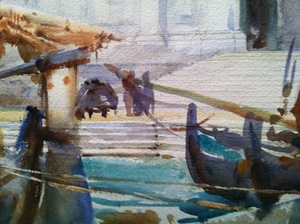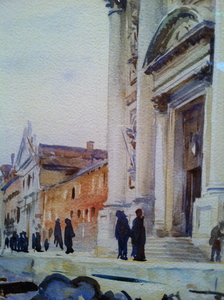Sargent
Watercolor: Translucence and Resolution
Friday, October 11, 2013

Sargent, "Lights and Shadows," 1909, iphone detail.
On Tuesday the baby and I saw the John Singer Sargent watercolors now up at the MFA. The baby saw much to please her. In addition to the particularly nice low cushioned gray benches, she liked best the room labeled “watercraft,” and in particular this image of boats, also my favorite:

We seemed both drawn to it simultaneously, though how much each might have anticipated the other’s preference is hard to determine. She could see immediately that it was boats and then called out the colors – first, her favorite, “orange!” and then, another color she particularly likes, and one pronounced in the picture, “green.”

In the last six months or so, watching the baby learn to name her surroundings, I’ve found again and differently how much of the pleasure of looking is naming. To know what a thing is called is to see it with a distinctness that, nameless, it lacks. One pleasure of Impressionism is of making out what’s there – that is a face, a hat, a shadow, a boat upon the water, a reflection. The Impressionist styles of painting slow down the eye’s recognition enough that you can feel, again, the early pleasure of coming-to-know-what’s-there.
This is also a pleasure of Sargent’s work. Though he was not an Impressionist, he developed just a little later and responded to some of the same influences. Many of the watercolors that are part of the exhibition are from the latter half of his career. Watercolor is a great late medium: translucent, indelible, it requires judgment and assurance from its maker.
A mature form for artists, it is also a late form for lookers – requiring subtleties of discernment and resolution. The more experience you’ve had looking at the world, the more astonished you feel to recognize the effects of diaphanous atmosphere in the watercolor. (Translucent is even one of the names for the kind of paint, the exhibition’s wall text lists both translucent and opaque watercolor.)
I had no idea if the baby would be able to see things in this medium – they require much more advanced powers of resolution than what she grasped a couple of months ago when we last went to look together. But, in the last room, labeled, I think, “light on stone,” when I said I wanted to look at this white house, she seemed pleased

and when I carried her over to it, she said, of her own accord, “clouds!” That’s right, I said. I took out the phone and she wanted to look at the picture of herself with a cat that she knows is on it, but when I said that I wanted to take a picture of the green door she approved and her tone suggested to me that she saw both the object and the way that taking a picture of it was like naming it, an act of recognition: “Door!”



[First two images iphone details of "Portuguese Boats," 1903, last four images iphone details of "Lights and Shadows," 1909.]



